Samsung Galaxy S 6 and S 6 Edge: Preview
by Joshua Ho on March 26, 2015 9:00 AM EST- Posted in
- Smartphones
- Samsung
- Mobile
- Galaxy S6
- Galaxy S6 Edge
GPU Performance
As previously discussed, on the GPU Samsung has added two additional shader cores to the Mali T760 for additional performance in addition to a clock speed bump from 700 to 772 MHz maximum. To evaluate the effects of this we look at GFXBench which is generally accepted as a pure GPU benchmark.

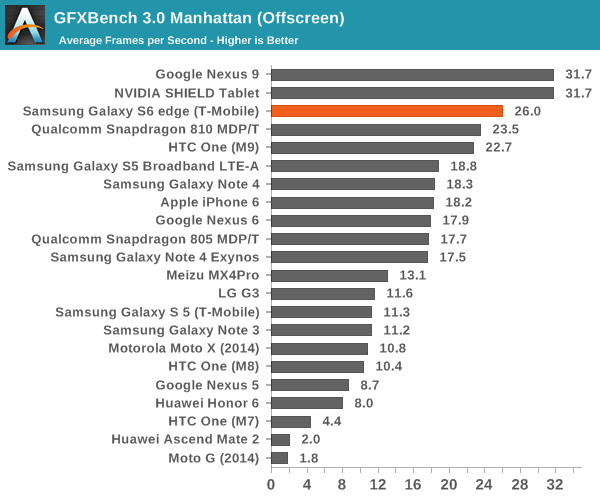
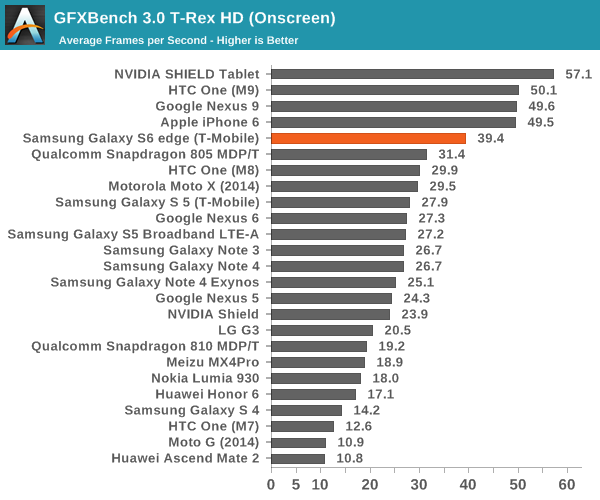
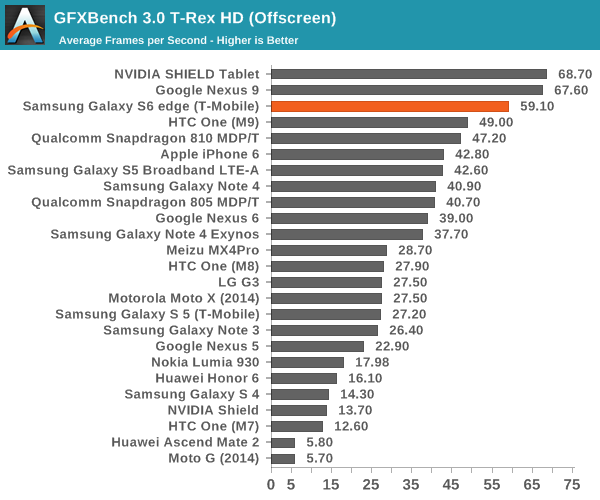
From the results the Mali T760MP8 GPU of the Exynos 7420 performs admirably in comparison to the Adreno 430 of the Snapdragon 810. We see a 10% lead over the Adreno 430 in Manhattan, growing to 20% in T-Rex. Qualcomm hinted that the Adreno 430 is more strongly improved in ALU performance over the Adreno 420, which would explain why the gap isn't as significant this generation. A 700 MHz clock on the Adreno 430 would likely equal to T760 in this case, but I suspect the power consumption of such a clock would be untenable. The Galaxy S6 does fall behind on the on-screen benchmarks due to the 1440p display compared to the 1080p display of the One M9, but rendering at a lower resolution would avoid most of these problems in real games.
Display
As previously discussed, the Galaxy S6 line introduces a newer generation of AMOLED displays, which is said to increase maximum luminance to 600 nits. Samsung claims that this was achieved with the use of new materials, which is likely necessary in order to sustain power efficiency improvements. It doesn't seem that AMOLED is uniquely suited to high resolution, but rather that Samsung Display Corp. is managing to dramatically improve how they make AMOLED displays with every year that offset power consumption increases from higher resolution displays. To find out how Samsung did, we use SpectraCal's CalMAN 5 Ultimate, in addition to X-Rite's i1Pro2 Basic to characterize displays as accurately as possible.
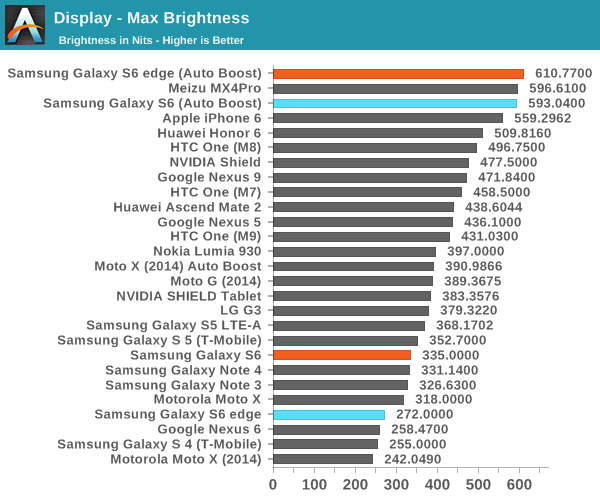
From the results Samsung's claims of a 600 nit display are valid in this case, which is a 100% APL white display. It's important to note that achieving this requires the use of auto-brightness, and that manual brightness is limited to a much lower brightness to reduce power usage, here the S6 sees similar maximum brightness as the S5. The S6 edge disappointingly only achieves 272 nits in this mode, a rather low value. I saw color balance shift dramatically in auto-boost mode, which suggests that this operating mode is likely less efficient than manual brightness. As an explanation, we've seen that colors are controlled in AMOLED by voltage while brightness is controlled by PWM (pulse width modulation). As with most recent AMOLED displays, there's no DC bias to the pixels so the contrast really is infinite instead of just a very large number when displaying black.
Galaxy S6
Galaxy S6 edge
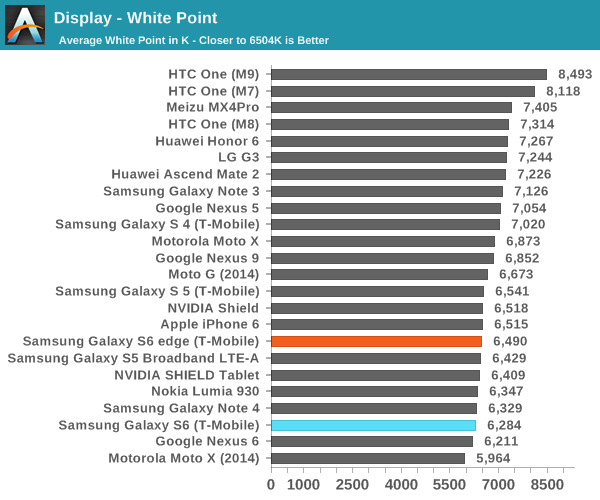
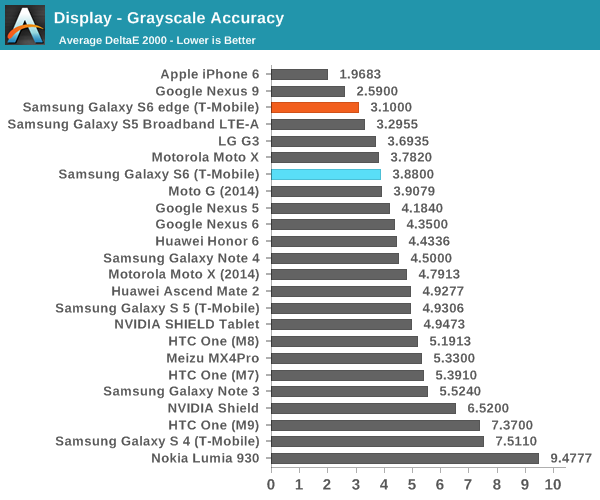
Moving on to grayscale, we can see that Samsung has done a pretty good job of controlling the white point and gamma across the saturation sweep, even if green is slightly dominant in both displays. We can also see that there is variation across displays as the S6 edge is closer to neutral while the S6 sample tends a bit warmer.
Galaxy S6
Galaxy S6 Edge
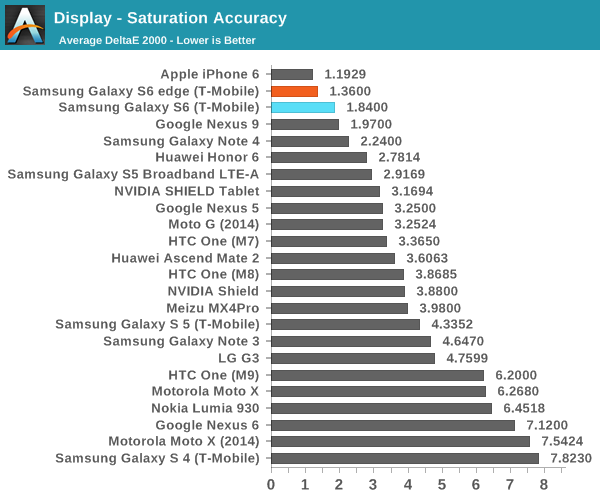
In the saturation sweep, both displays do an incredible job. I really don't have anything else to say here, because there's really no way to improve on the level of calibration Samsung has done on this display. Unless Samsung calibrates every single display in production, which is wildly impractical and effectively impossible to do, this is as good as it gets for a mass-produced device. Improving past this point will also be incredibly difficult to perceive, which means there's no real reason to go any further.
Galaxy S6
Galaxy S6 edge
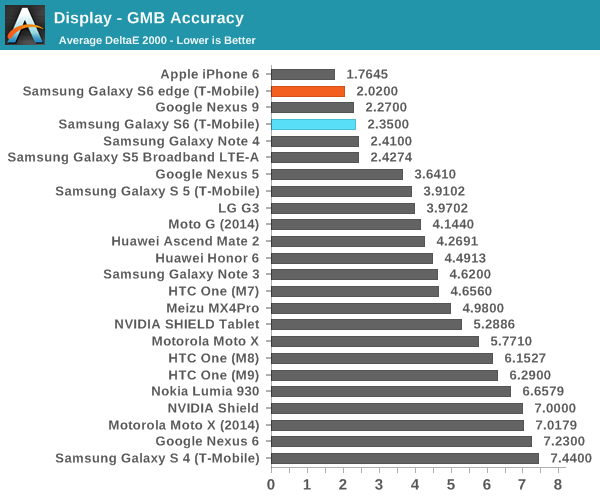
In the Gretag MacBeth ColorChecker, we can get an idea for overall color accuracy, which paints a picture similar to the saturation test. The only real problem I've noticed with these displays are the viewing angles, which can produce color shifting when the display is tilted. This is a bit of an issue on the edge variant as I can see that the edges of the display appear somewhat green when viewed head on, but otherwise there are no real issues to be seen here. Overall, this is probably the best display anyone will be able to get in a smartphone right now. This level of progress is amazing from Samsung, given just how bad things were with the Galaxy S' AMOLED display, even as recent as the display of the Galaxy S4. With the Galaxy S5 review, I said that I wouldn't be surprised to see AMOLED equal, if not exceed LCD within a year or two, and Samsung has managed to finally hit that mark.



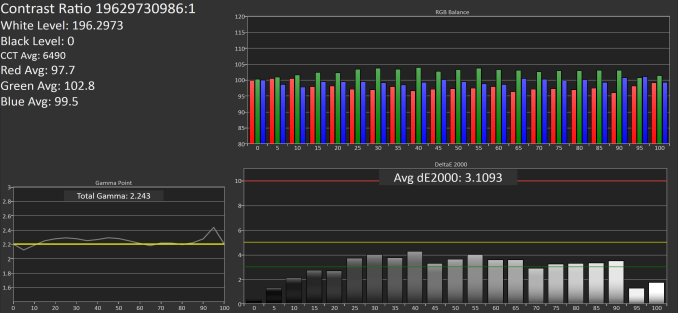
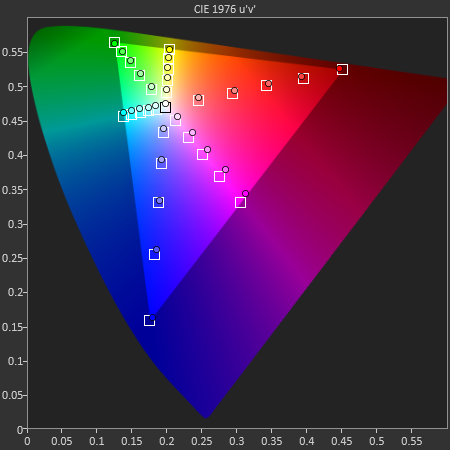
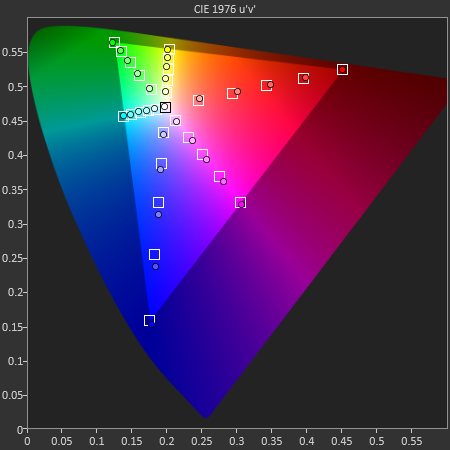
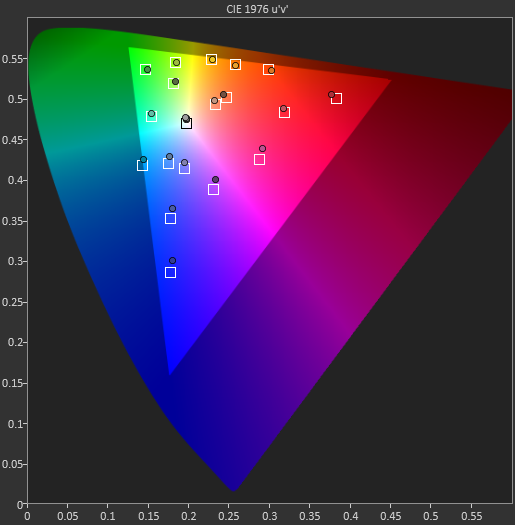









200 Comments
View All Comments
acastle5 - Thursday, March 26, 2015 - link
Thank you danbob999, that's why these one year 'trade in/up' models are so over priced and bogus through ATT. If I had a Samsung s5, I wouldn't even be considering an upgrade at this point. Maybe in a year or two when the Nex-Gen comes around... I happen to have the s3, which is why it makes sense for me to go ahead and upgrade at this point, buy the phone on the two year plan at a discounted rate and go from there with the new s6 edge... I wont need another phone for about 4 years or so...rocketbuddha - Thursday, March 26, 2015 - link
Josh,Since your unit says TMobile,
a) What is the Cat 6 LTE Modem?
b) Is it a Samsung part or a Intel/ST Micro/Marvell part
c) How good is the Samsung LTE modem at the T Mobile bands including the Band 12
IIRC this is the first time a Samsung is using a non-QCOM Modem chip in the US is with its Galaxy Nexus on Verizon using a Via Telekom CDMA/EVDO + LTE chip.
I will be interested to know if the second time is a charm :D
SydneyBlue120d - Friday, March 27, 2015 - link
I'd like to know also if LTE-A, VoiceOverLTE and HD Voice is officially supported and if such support is available also in European version of the phones.ama3654 - Thursday, March 26, 2015 - link
Would it make any difference if the benchmark apps are 64bit as well? Just like on iOS devices.chizow - Thursday, March 26, 2015 - link
Tired of Qualcomm's lack of innovation the last few years, and don't trust Samsung's Exynos enough to go with S6, so I broke down and got myself an iPhone 6 Plus. Figure if Samsung is going to get rid of most of the stuff I liked about their phones (removable battery, expandable storage via microSD), I would just go with the best non-Nvidia SoC on the market. And don't even start on battery life. Galaxy/Android starts off great but then you start getting random processes that loop and cause a fire in your pocket and you need to charge multiple times during the day.So yes, Apple gets my business now that they've finally caved and gone with a real screen. We'll see if it bends.
Darkito - Thursday, March 26, 2015 - link
If you have an issue with wakelocks on Android, there are ways to fix it. I realize it's suboptimal to have to do it yourself (and it requires root) but BetterBatteryStats shows you exactly what app is responsible for the wakelock.The best SoC as of now is the A8X. The best phone SoC is clearly the Exynos in the S6 though.
kmmatney - Friday, March 27, 2015 - link
I also switched back to iPhone for similar reasons. I rooted my phone, tried different ROMS (bricked my phone once, which required factory software tools to get it back) but never had consistent battery life, and the UI speed was never consistent. I switched to Android as I wanted a larger phone, and I loved the 5.5" 1080p IPS screen. I never used the replaceable battery feature - it's not worth the hassle to keep a second battery around (and keep it charged). I downgraded to a 64GB iPhone 5 for $200 to hold me off until I can upgrade again in September. Battery life is much better with my new 3 year old iPhone. I can replace the battery easily enough if needed, but Apple batteries tend to last a long time. I don't trust Samsung with a non-replaceable battery - I've had several Samsung phones in the past and plenty of dead batteries.chizow - Saturday, March 28, 2015 - link
Yeah maybe on paper the Exynos looks great but again, I don't trust Samsung's SoCs after that whole crossbar issue they had with their S4 big.Little design and the various SoC bench cheat scandals.I just know every iOS device I pick up even months later that has an A7 or better SoC performs great and gives consistent battery life and screen experience, all despite the fact these phones are operating on just 1GB of RAM.
Android is just a hodge podge of bloated, hacked/stolen code. If you have to resort to root and strip half the crap/bloat out of it, just tear it down and start anew.
MercuryHero - Tuesday, April 14, 2015 - link
If someone complains about a flaw in Android as the reason they went to iPhone, it's less than helpful to start talking about root-only tools that you can use to troubleshoot and diagnose the problem; that just makes Android look worse. You should not have to root, learn technical terms like "wakelock" or diagnose the cause of an issue when simply using a phone.That said, it's always the fault of the misbehaving app, not Samsung, or Android - who are designed to implicitly trust that when an app says it needs to keep the phone awake while the screen's off, that the app knows what it's talking about.
I'd personally like to see some more in-built smarts in Android relating to knowing when an app has been permitted to keep the phone awake, but it shouldn't be happening *constantly* - some sort of rate limiter that can be tuned to each app so that, for example, an app that only needs to sync occasionally should be prevented from operating a wakelock once it's apparent that the wakelock is not being released as quickly as it would be expected to.
But that's all stuff for Android internals, and consumers basically just have to put up with the current state of affairs, and just (hopefully) learn that the cause of problems is the misbehaving app.
klagermkii - Thursday, March 26, 2015 - link
Could you please test the minimum white brightness of the AMOLED display? One of the problems I've had with switching to an AMOLED phone is that even at its lowest brightness it's still too bright to read against a white background at night compared to other LCD phones.